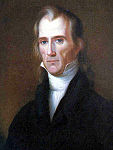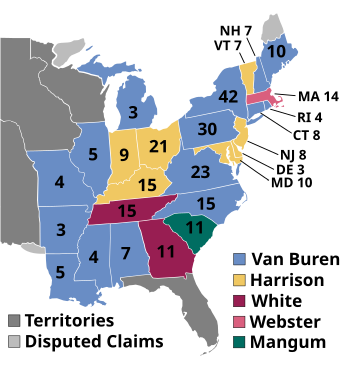United States presidential election, 1836
|
|
|||||||||||||||||||||||||||||||||||||||||||||||||||||||||||||||||||||||||||||||||||
|
|||||||||||||||||||||||||||||||||||||||||||||||||||||||||||||||||||||||||||||||||||
|
|||||||||||||||||||||||||||||||||||||||||||||||||||||||||||||||||||||||||||||||||||
|
|
|||||||||||||||||||||||||||||||||||||||||||||||||||||||||||||||||||||||||||||||||||
| Presidential election results map. Blue denotes states won by Van Buren and Johnson or Smith, pale grey-purple denotes those won by Harrison and Granger or Tyler, purple denotes those won by White/Tyler, coral pink denotes those won by Webster/Granger, and bluegrass green denotes those won by Mangum/Tyler. Numbers indicate the number of electoral votes allotted to each state. | |||||||||||||||||||||||||||||||||||||||||||||||||||||||||||||||||||||||||||||||||||
|
|||||||||||||||||||||||||||||||||||||||||||||||||||||||||||||||||||||||||||||||||||
The United States presidential election of 1836 was the 13th quadrennial presidential election, held from Thursday, November 3, to Wednesday, December 7, 1836. As the third consecutive election victory for the Democratic Party, it ushered incumbent Vice-President Martin Van Buren into the White House with 170 electoral votes to 124 electoral votes for William Henry Harrison and other Whigs. The popular vote was closer; Martin Van Buren attracted 764,000 votes to the 738,000 won by the various Whig candidates.
The election of 1836 is principally remembered for three distinctive circumstances. The most important was the strategy of the Whig party in running several presidential candidates simultaneously. No major party before or since ever attempted this. In 1836, the Whigs ran four candidates in different parts of the country in hopes that each would be popular enough to defeat Democrat Martin Van Buren in their respective regions. In that case, it would have been left to the House of Representatives to decide between the competing Whig candidates. This strategy failed: Van Buren won a majority of electoral (and popular) votes and became president.
The election of 1836 was also the last until 1988 to result in the elevation of an incumbent vice president to the nation's highest office through means other than the president's death or resignation, and the only one in which a vice presidential election was thrown into the United States Senate.
...
Wikipedia






